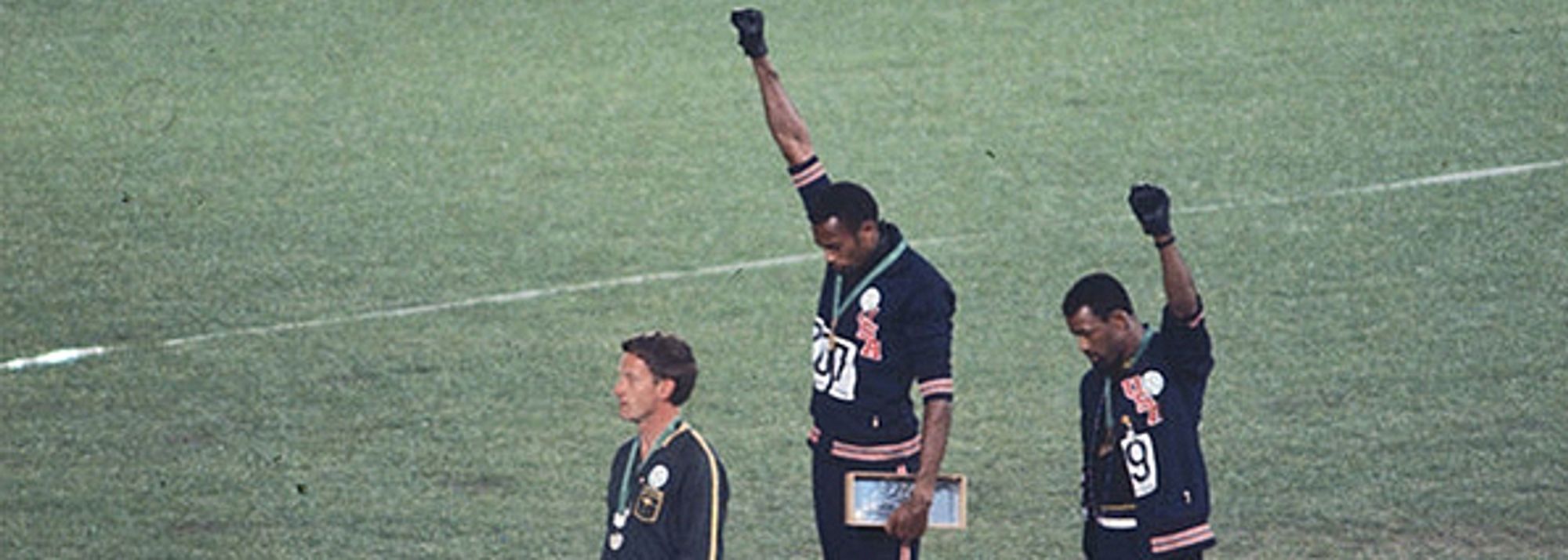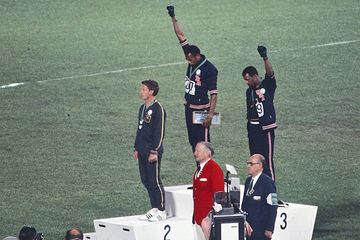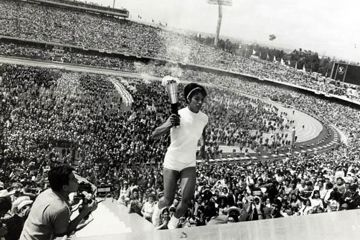Peter Norman, Tommie Smith and John Carlos on the 200m podium at the 1968 Olympic Games in Mexico City (© Getty Images)
Fifty years ago today, 16 October 1968, at the cavernous Olympic stadium in Mexico City, US sprinters Tommie Smith and John Carlos joined together to produce one of the most iconic and enduring sporting moments of the 20th century.
With a massive global platform that only an Olympic Games can provide, the freshly-minted gold and bronze medallists in the 200m chose to use their moment of glory to protest the racial inequality that was ripping their country apart. It was a protest the likes of which had never been witnessed on an international sporting stage - not before, and not since.
Just hours after their medal-winning performances --Smith broke the world record with a stunning 19.83 run-- the pair walked solemnly towards the medal podium, each carrying a shoe behind their backs, with just black socks covering their feet. As the national anthem began to play, each athlete bowed his head and raised a single black-gloved fist, Smith his right, Carlos his left. At just 24 and 23, respectively, Smith and Carlos became the subjects of an indelible image of a salute that would come to symbolise an era, inspire every generation since and one that would define, in times both bad and good, the rest of their lives.
Details of their protest were planned. The black gloves, Smith said, represented social power and unity; wearing black socks without shoes represented African-American poverty; the black scarf he wore around his neck --and the beads worn by Carlos-- symbolised the lynchings of African-Americans. All they had to do was earn their way to the podium.
Apropos, the race itself, held late that morning, is the stuff of legend.
Carlos, the pre-race favourite, started strong, carrying a visible lead as the field shot off the final bend. But as he approached the homestraight's midway point, Smith, propelled by a running style that was both silky smooth and brutally powerful, accelerated as few before or after have. Running the final dozen strides with arms aloft in celebration, Smith clocked 19.83, a world record that would last nearly 11 years. Behind him, Carlos lost his composure in the waning stages and began to stagger. Australian Peter Norman, running in lane six, took full advantage, using his strong late race strength to run down Carlos just four strides from the finish line. He clocked 20.06, a national record that still stands.
Few realised then that Norman also took part in the protest. Like Smith and Carlos, he also pinned a badge on his jacket from the Olympic Project for Human Rights, the movement that inspired the protest. He immediately confirmed his full support of Smith and Carlos’s action.
While recognized as heroes now, Smith and Carlos paid a steep price for their protest. Both were immediately expelled from the Olympic Village and returned home where, instead of a hero's welcome, they were met with death threats and vilification. Ostracised from their sport, their careers on the track were over two years later and decades of personal and professional struggles followed. Their fortunes began to change in the 1980s when both eventually found their calling as successful coaches. By 2005, a seven-metre high statue of their podium moment was unveiled on the campus of San Jose State University, where the US teammates were students. In 2016 they were recognised at the White House by then US President Barack Obama.
Looking back: first-hand accounts from Mexico City
We asked journalists Ed Fox, now the Publisher Emeritus of the US monthly Track and Field News, and a veteran of 12 Summer Olympic Games, and Jim Webster, who covered the Mexico City Games --one of eight he's attended-- for the Sydney Morning Herald, to share some of their recollections of the lead-in to the 200m competition, the race itself, and the protest and its aftermath, events they both consider among the most poignant and memorable of their long careers. Their thoughts are below.
Ed Fox writes:
I had expected Tommie Smith to win the 200; I had watched the "match race" between him and Lee Evans at San Jose State, with Tommie setting a 440y world record the year before, and he instantly became my favorite runner.
The whole year leading up to the Olympics was filled with uncertainty, with Vietnam protests, civic unrest, racial tensions, horrific assassinations, and of course the Olympic Project For Human Rights. Track & Field News' editor Dick Drake ran a long interview with Tommie and Lee revealing their thoughts about what they could do to further racial equality in regard to the Olympics.
We saw Tommie limp off after the Mexico City semi, and then appear for the final with a taped thigh (if I recall right). Carlos had to be the favorite off his "world record" at Echo Summit (the high-altitude venue in California where the US Olympic Trials were held), but Tommie ran his greatest race and won with plenty to spare with a splendid world record. I was shocked that Carlos was nosed out for second by a relatively unknown Australian! Had he given up when he knew he wasn't going to beat Tommie?
As a former New York liberal I found their demonstration on the victory stand to be quite mild under the circumstances and quite appropriate. Not so with many of my fellow Americans in the stands who spewed venom at the two medalists; I should have been surprised, but wasn't. Tommie and John are heroes now.
Mexico City was my first Olympics and I've been fortunate to be able to attend 11 more. Somehow Mexico City remains the most vivid and memorable, with Tommie and John and the victory stand central in those memories.
And Jim Webster writes:
The Mexico City Olympics always threatened to be different in so many ways, especially given the high altitude.
High on the list of potential Australian medal-winners was our sprinter Peter Norman, who I knew quite well from my years as an athletics writer. He always stood out, in several different ways. Apart from being phenomenally fast, he showed his strong religious beliefs by always wearing a tracksuit carrying the words GOD IS LOVE on the back.
The other unusual feature with Peter was the way he ran his races, especially over his favoured distance of 200 metres. Peter would always start with the rest of the field and stay amongst them until he reached the 150-metre mark. Then he would suddenly move into another gear entirely. Nobody could understand how he did this, but it was a remarkable sight to see him hit this express button and suddenly take off like a bullet.
When the Olympics began, I ventured out onto the athletics training track one day to observe the two high-profile Americans thought to be the ones who would contest the gold and silver medals in the 200m, Tommie Smith and John Carlos.
There seemed no question that the battle for gold would be between these two, both students at San Jose State College in California and both members of the Olympic Project for Human Rights, a group of athletes organised to protest the treatment of blacks in the United States.
Smith held 11 world records, indoors and outdoors. Carlos had beaten Smith for the first time at the US Olympic trials and clocked an (unratified) world record 19.7. So the stage was set for a historic fight for the gold medal between these two. No-one else. Definitely not.
On this particular day when I went to watch them training I later approached Carlos and introduced myself from The Sydney Morning Herald. Basically, I said the 200 metres was sure to be one hell of a race, but then don’t completely dismiss our Peter Norman. I told him about Peter’s extraordinary finish, but was immediately waved away. ”It’ll be the US first and second,” Carlos said.
A few days later came the big race. The atmosphere among the tens of thousands in the packed stadium was electric. Then away they went. Carlos led coming out of the turn, but then Smith turned on a stunning display of speed, passed his teammate with 60 metres to go and won easily, his arms raised before he hit the tape, in a world record.
Carlos turned his head to watch Smith go flying by, allowing none other than Norman, who had been in only sixth place entering the straight, to release his amazing finish and take the silver medal.
Norman told me later that before the three of them went out for the medal presentation, the Americans told him what they planned to do, but then discovered they only had one pair of black gloves between them, and not two. It was Norman who told them that one of them should wear a glove on his right hand, the other on his left hand. The rest is history.
I can still see the three of them on the victory dais, all wearing civil rights badges, each of the Americans with black-gloved hand raised and head bowed, with Norman upright and looking straight ahead. Even then I saw this as a moment in history that would never be repeated. All the media, officials and public around me in the packed grandstand were equally stunned. It strengthened my belief in the message they were delivering.
The Americans later explained that their clenched fists symbolised black strength and unity and they had bowed their heads when “the Star-Spangled Banner” was played to express their belief that the words of freedom in the US national anthem only applied to Americans with white skin.
Olympic officials were outraged at what Smith and Carlos had done. The International Olympic Committee told the US Olympic Committee that Smith and Carlos should be banned from competing again in the Olympics, in the relays, and to expel them from the Olympic Village.
When the USOC refused, the IOC told the USOC that if these directions were not followed then the entire US track and field team would be barred from further competition. This time the US Olympic Committee had no option but to comply.
The global response to the demonstration was largely sympathetic, but back home in the US it was not well received and both of them found it difficult thereafter to find employment, and both their marriages broke up.
However, eventually they did find jobs, Smith in track coaching and Carlos in more menial jobs. But Carlos’ experience turned full circle when he was hired in 1982 by the Los Angeles Olympic Organising Committee to promote the 1984 Games.
Norman also paid a heavy price. His continuing track career was plagued by ups and downs. He retired shortly after finishing fifth at the 1970 Commonwealth Games in Edinburgh, but came back in an effort to qualify for the 1972 Olympics in Munich. But he carried a knee injury into the Olympic trials, finished third in his favoured 200m and was omitted from the Australian team.
However, there remains to this day a strong belief among fellow competitors that he should have been chosen; that his past performances and ability when he was fully fit was enough justification for him to be included and that the Australian Olympic Committee could well have been influenced by the events in Mexico City.
When Norman passed away in 2006, it was incredible to think that those two Americans came all the way to Australia to be pall-bearers at his funeral. That bond of friendship, formed on the medal dais in 1968, stands out among the strongest and most emotional memories of my long career, which took me to eight Olympic Games.
Bob Ramsak, Ed Fox and Jim Webster for the IAAF







